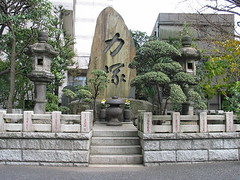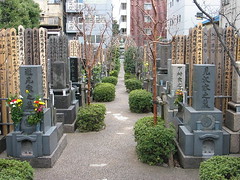Eko-in

THE "POWER MOUND"
Just inside the Kokugikan's entrance hall was a glass display case filled with sumo trophies. There was a giant chrome Coke bottle—"the Coca-Cola trophy," according to the plaque at its base. Another trophy was a huge glass cylinder filled with dehydrated mushrooms. The "Czech cup" was a giant crystal goblet that stood in front of a Pilsner Urquell beer poster.
I was looking over the trophies when I heard someone call my name. I looked up and saw a youngish guy with slicked-back bangs in a gray-checked blazer and black pants. I guessed, correctly, that it was Miki.
Miki hustled me out of the entry hall and into the public relations office, the same place where I had met the Oyakata. He had a Yomiuri photographer take me into the hallway and shoot my picture for the tournament press pass he'd promised me. Back inside the office, the newspaper reporters and photographers who'd collected there were picking over a tableful of press swag: press releases, DVD's, photos.
Also on the table was a small selection of Hello Kitty figurines wearing sumo-related costumes: Kitty in a gyoji's vestments, Kitty in a kesho mawashi. One even had Kitty's white kitten head perversely transposed onto the round, flesh-colored body of a mawashi-wearing sumo wrestler.
Miki had me wait for him while he typed into his laptop, which he had jacked into his cellular phone. Then he took me to lunch at a tempura restaurant and ordered us both bowls of scrambled shellfish over rice, with which we drank beer.
Miki ate quickly. When we left the restaurant, he told me I could come to the Kokugikan any time the next day—the first of the tournament—and pick up my press pass, which would let me come and go as I pleased. Before we split up, I had him show me the way to the Eko-in temple, which I was interested in checking out because of its connection to sumo wrestling.
Eko-in, in fact, is what brought sumo to the Ryogoku section of what's now Tokyo in the first place. It was built in the mid-18th century to inter and memorialize the 100,000-plus victims of a fire that had destroyed much of the city about 100 years earlier. But Eko-in didn't have access to the cash stream that supported most temples: since its graves were anonymous, it couldn't collect dues from the family members of those that it interred. So it began sustaining itself with biannual sumo matches, which thousands attended.
Sumo on temple grounds was nothing new. Temples and shrines had long raised money by hosting the hodgepodge of disenfranchised samurai and migrants from the countryside that performed the prizefights that became modern sumo. Before Eko-in began hosting the matches, most were held on the grounds of the Fukagawa Hachiman shrine down the Sumida river. But once they moved to Eko-in, it became the chief venue for sumo and Ryogoku soon became the sport's de facto headquarters.
In the early 20th century, sumo gained new prestige, as the flurry of national pride that followed Japan's victories in its recent wars with China and Russia turned the Westernizing country's gaze back toward its native culture. As a uniquely Japanese expression, sumo wrestling was elevated to Japan's national sport and given a permanent home: the Kokugikan that was built near the temple.
These days, though, the only thing that seems to link Eko-in to its sumo past is the stone with the inscription "power mound" near its entryway, which was erected in the 1930's as a memorial to a wrestler. The temple itself sits at the end of a busy road behind a corporate-looking cement-and-steel archway. Gone are the vast temple grounds that allowed it to house the massive temporary structures in which sumo was once performed. It's now a cluttered compound of modern one-story buildings. But its history as a graveyard remains on clear display in the dense block of tombs off to the side.

NEXT: Morning at the Tournament



<< Home